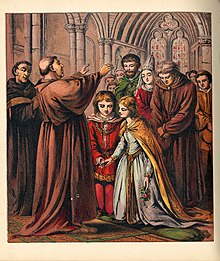User:OwlUSA/sandbox
Teen marriage or adolescent marriage is a marriage between an adult and a teen or an adolescent under the age of majority (typically under 18 years old or 21 years old) but older than 12 years old or 14 years old. Not to be confused with teenage marriage. The teen or adolescent can be a female or a male, but the large majority of teen marriages or adolescent marriages are between a teen or adolescent female and an adult male.
Although the age of majority (legal adulthood) and marriageable age are usually designated at age 18, both vary across countries and therefore the marriageable age may be older or younger in a given country. Many jurisdictions permit earlier marriage with parental consent or in special circumstances, such as teenage pregnancy.
In Ancient Greece, early marriage and motherhood for females existed. [1] Females could marry above the age of 14 years old and males could marry above the age of 16 years old. In Ancient Rome, females could marry above the age of 12 years old and males could marry above the age of 14 years old. [2] In the Middle Ages, under English civil laws that were derived from Roman laws, marriages before the age of 16 existed.
In medieval societies, females could be betrothed at 12 years old and even at 7 years old. Females could be married at 14 years old and even at 12 years old.
According to the 1907 Catholic Encyclopedia, apocryphal accounts that, at the time of her betrothal to Joseph, Mary, the mother of Jesus, was 12–14 years old.[3]

Historically within the Catholic Church, prior to the 1917 Code of Canon Law, the minimum age for a dissoluble betrothal (sponsalia de futuro) was seven years in the contractees. The minimum age for a valid marriage was puberty, or nominally 14 for males and 12 for females.[4] The 1917 Code of Canon Law raised the minimum age for a valid marriage at 16 for males and 14 for females.[5] The 1983 Code of Canon Law maintained the minimum age for a valid marriage at 16 for males and 14 for females.[6]: c. 1083 §1 [a]
English ecclesiastical law forbade marriage of a female before the age of puberty.[8]
- ^ Nancy Demand (1994), Birth, Death, and Motherhood in Classical Greece, Johns Hopkins University Press, pages 101–104
- ^ Dahl, GB (2010). "Early Teen Marriage and Future Poverty". Demography. 47 (3): 689–718. doi:10.1353/dem.0.0120. PMC 3000061. PMID 20879684.
- ^ "St. Joseph". Catholic Encyclopedia. Newadvent.org. Retrieved September 30, 2013.
- ^
 One or more of the preceding sentences incorporates text from a publication now in the public domain: Rock, P. M. J. (1907). "Canonical Age". In Herbermann, Charles (ed.). Catholic Encyclopedia. Vol. 1. New York: Robert Appleton Company.
One or more of the preceding sentences incorporates text from a publication now in the public domain: Rock, P. M. J. (1907). "Canonical Age". In Herbermann, Charles (ed.). Catholic Encyclopedia. Vol. 1. New York: Robert Appleton Company.
- ^ Bachofen, Charles A. (1920). A commentary on the new code of the canon law. Vol. 5 (2nd rev. ed.). St. Louis, MO; London: B. Herder book. c. 1067. hdl:2027/wu.89088314570. LCCN 19004568.
{{cite encyclopedia}}: Missing or empty|title=(help) - ^ a b c d e f g Catholic Church (1999) [©1998]. "Codex Iuris Canonici". Code of canon law: new English translation. IntraText. Washington, D.C.: Canon Law Society of America. ISBN 978-0-943616-79-7. Archived from the original on 2008-02-20 – via Vatican.va.
- ^ Peters, Edward N. (1996-06-22). "Too young to marry". America. 174 (20): 14–16. ISSN 0002-7049. Reprinted in Peters, Edward. "Too young to marry". canonlaw.info. Archived from the original on 2006-02-21. Retrieved 2015-09-06.
- ^ Richard Burn, Robert Tyrwhitt and Robert Phillimore, The Ecclesiastical Law, Volume 4, Sweet Stevens & Norton (London), page 54.
Cite error: There are <ref group=lower-alpha> tags or {{efn}} templates on this page, but the references will not show without a {{reflist|group=lower-alpha}} template or {{notelist}} template (see the help page).

